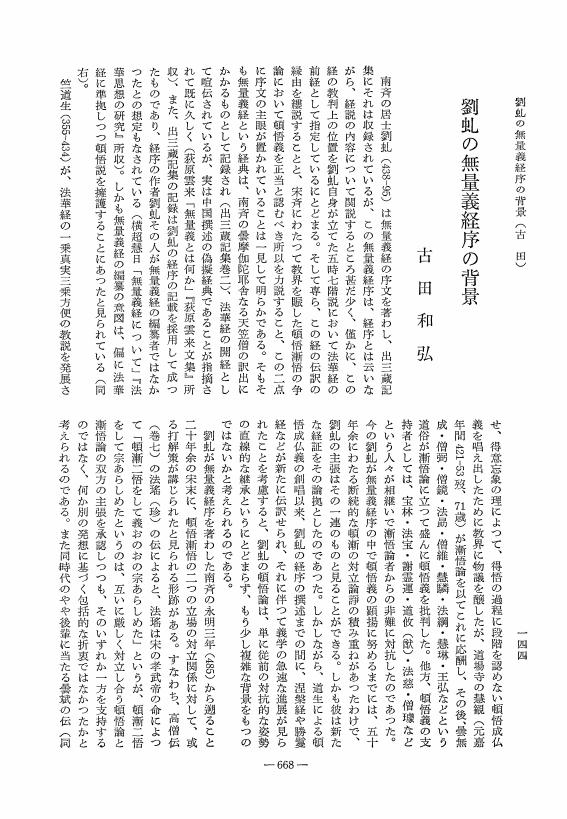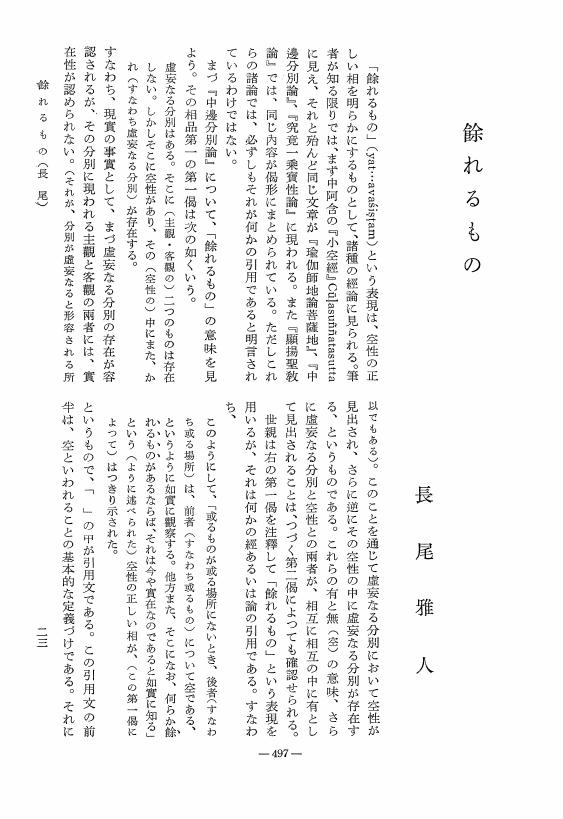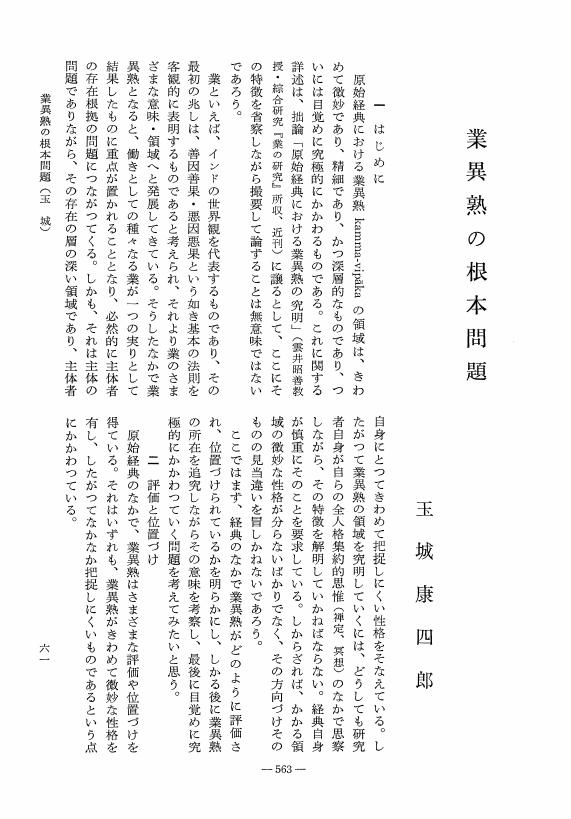1 0 0 0 OA 中有の機能について
- 著者
- 池田 練太郎
- 出版者
- Japanese Association of Indian and Buddhist Studies
- 雑誌
- 印度學佛教學研究 (ISSN:00194344)
- 巻号頁・発行日
- vol.39, no.2, pp.926-922, 1991-03-20 (Released:2010-03-09)
- 被引用文献数
- 1 4
1 0 0 0 OA 無にして一の限定へ -維摩經・入不二法門品について-
- 著者
- 兒山 敬一
- 出版者
- Japanese Association of Indian and Buddhist Studies
- 雑誌
- 印度學佛教學研究 (ISSN:00194344)
- 巻号頁・発行日
- vol.7, no.1, pp.57-66, 1958-12-01 (Released:2010-03-09)
1 0 0 0 OA 劉〓の無量義経序の背景
- 著者
- 古田 和弘
- 出版者
- Japanese Association of Indian and Buddhist Studies
- 雑誌
- 印度學佛教學研究 (ISSN:00194344)
- 巻号頁・発行日
- vol.25, no.2, pp.668-669, 1977-03-31 (Released:2010-03-09)
1 0 0 0 OA Bhatta Lollata の rasa 論
- 著者
- 上村 勝彦
- 出版者
- Japanese Association of Indian and Buddhist Studies
- 雑誌
- 印度學佛教學研究 (ISSN:00194344)
- 巻号頁・発行日
- vol.34, no.1, pp.424-416, 1985-12-25 (Released:2010-03-09)
1 0 0 0 OA 『立正安国論』と『吾妻鏡』
- 著者
- 関戸 堯海
- 出版者
- Japanese Association of Indian and Buddhist Studies
- 雑誌
- 印度學佛教學研究 (ISSN:00194344)
- 巻号頁・発行日
- vol.45, no.1, pp.232-236, 1996-12-20 (Released:2010-03-09)
1 0 0 0 OA 中国仏教の道教的展開
- 著者
- 道端 良秀
- 出版者
- Japanese Association of Indian and Buddhist Studies
- 雑誌
- 印度學佛教學研究 (ISSN:00194344)
- 巻号頁・発行日
- vol.19, no.2, pp.544-549, 1971-03-31 (Released:2010-03-09)
1 0 0 0 OA 大乗仏教における他者の発見
- 著者
- 丘山 新
- 出版者
- Japanese Association of Indian and Buddhist Studies
- 雑誌
- 印度學佛教學研究 (ISSN:00194344)
- 巻号頁・発行日
- vol.50, no.2, pp.885-879, 2002-03-20 (Released:2010-03-09)
1 0 0 0 OA 解脱に関する考察 -解脱への仏教学的方法を含めて-
- 著者
- 玉城 康四郎
- 出版者
- Japanese Association of Indian and Buddhist Studies
- 雑誌
- 印度學佛教學研究 (ISSN:00194344)
- 巻号頁・発行日
- vol.33, no.1, pp.39-46, 1984-12-25 (Released:2010-03-09)
1 0 0 0 OA 中国北朝仏教における禅について
- 著者
- 白山 和宏
- 出版者
- Japanese Association of Indian and Buddhist Studies
- 雑誌
- 印度學佛教學研究 (ISSN:00194344)
- 巻号頁・発行日
- vol.49, no.1, pp.73-75, 2000-12-20 (Released:2010-03-09)
1 0 0 0 OA 龍樹の縁起観・仏陀観
- 著者
- 五島 清隆
- 出版者
- Japanese Association of Indian and Buddhist Studies
- 雑誌
- 印度學佛教學研究 (ISSN:00194344)
- 巻号頁・発行日
- vol.58, no.3, pp.1203-1211, 2010-03-25 (Released:2017-09-01)
龍樹の思想を理解するには,その縁起観の解明が欠かせない.というのも,彼自身はブッダ(釈尊)が説いた縁起を空性と捉えており,一方で,現代の研究者の多くは龍樹の縁起を「相互依存(相依性)の縁起」と捉えているからである.私の研究によれば,『中論頌』における「縁起」の根底にあるのは仏説としての「十二支縁起」であり,邪見・顛倒の断滅による涅槃を目的とした十二支縁起(とくに還滅分)を,戯論の寂滅・分別の滅によって解脱に至る吉祥なる教え(つまり空性の縁起)として捉え直したものである.また,「相互依存の縁起」という捉え方は,まず『空七十論』において強調され,『無畏論』や『青目註』において発展的に継承されていき,一方では『ヴァイダルヤ論』において概念間の関係として展開していき,最終的には,月称によって確立されたものである.つまり,龍樹作とされる文献群やその註釈書においてその縁起観は変化・展開しているのである.その際,注目すべきは,各文献に見られる仏陀観である.龍樹作とされる文献群には「単数形のブッダ」と「複数形のブッダ」の対比が見られるが,『中論頌』では,前者が釈尊を指し,後者は龍樹の思想的支援者(あるいは「大乗のブッダ」)を指している.ところが『六十頌如理論』では逆に,「単数形のブッダ」が「不生不滅」の縁起を説くブッダであり,「複数形のブッダ」は伝統的教理の説者となっている.これが『宝行王正論』になると,「複数形のブッダ」は伝統的な教理も大乗の教理も説く,いわば普遍的な存在と捉えられている.この仏陀観の違いは,各文献の著者が異なることを示している.同様に,龍樹文献群における縁起観の変遷も単に龍樹個人の思想的な発展・深化ではなく,著者そのものの違いを示唆していると考えられる.
1 0 0 0 OA 瑩山禅師と密教の関係について
- 著者
- 竹内 弘道
- 出版者
- Japanese Association of Indian and Buddhist Studies
- 雑誌
- 印度學佛教學研究 (ISSN:00194344)
- 巻号頁・発行日
- vol.49, no.1, pp.211-214, 2000-12-20 (Released:2010-03-09)
1 0 0 0 OA 餘れるもの
- 著者
- 長尾 雅人
- 出版者
- Japanese Association of Indian and Buddhist Studies
- 雑誌
- 印度學佛教學研究 (ISSN:00194344)
- 巻号頁・発行日
- vol.16, no.2, pp.497-501, 1968-03-31 (Released:2010-03-09)
1 0 0 0 OA 業異熟の根本問題
- 著者
- 玉城 康四郎
- 出版者
- Japanese Association of Indian and Buddhist Studies
- 雑誌
- 印度學佛教學研究 (ISSN:00194344)
- 巻号頁・発行日
- vol.27, no.2, pp.563-571, 1979-03-31 (Released:2010-03-09)
1 0 0 0 OA 律蔵の成立問題に関する現在の状況
- 著者
- 佐々木 閑
- 出版者
- Japanese Association of Indian and Buddhist Studies
- 雑誌
- 印度學佛教學研究 (ISSN:00194344)
- 巻号頁・発行日
- vol.54, no.2, pp.938-931,1331, 2006-03-20 (Released:2010-03-09)
At present we do not have a clear understanding of the historical process through which the existing Vinaya materials came into being. One of the most noteworthy points in this field is the difference in structure between Theravada Vinayas and the Mahasamghika Vinaya. It is thought that the compilation process of the Vinaya may be clarified by explaining the reason for this difference. On this point, scholars such as Frauwallner, Hirakawa, Yinshun, Clarke and myself have presented various theories. Clarke's theory, the most recent addition to the discussion, rejects the thesis of Frauwallner's famous work. If Clarke's criticisms are correct, then his interpretation is a revolutionary contribution to the study of the Vinaya. However, there is a serious logical contradiction in Clarke's theory, and therefore Frauwallner's theory cannot be dismissed. In this article, I will outline these past theories and point out the problems in Clarke's work.
1 0 0 0 OA 手足網縵相の意味
- 著者
- 勝本 華蓮
- 出版者
- Japanese Association of Indian and Buddhist Studies
- 雑誌
- 印度學佛教學研究 (ISSN:00194344)
- 巻号頁・発行日
- vol.54, no.1, pp.408-402,1273, 2005-12-20 (Released:2010-07-01)
Jala-hatthapada is one of the thirty-two characteristics of a great man like the Buddha. In Northern Buddhism, it implies that He had membranes/webs between the digits of His hands and feet.However, Buddhaghosa's commentaries refute this idea. Buddhaghosa argues that under the rule of the Vinaya, such a man cannot become even a monk. Moreover, the commentaries explain that the lines formed by the digits and their knots in the great man appear like nets.Some scholars argued this matter and concluded that the idea of webbed digits emanated from a misinterpretation of the sculptures of the Buddha, whose digits were connected by sculptors to prevent them from fracturing.In this paper, I attempt to demonstrate that the idea of webbed digits originates from the Sarvastivada school. The evidence is as follows. The word “hamsa-raja” (the king of ganders) appears as a simile of jalini-panipada (=jala-hatthapada) in a Sanskrit scripture, namely, the Mahavadana-sutra, and in the Chinese versions of other sutras; all of these were disseminated by the same school. Moreover, I found pictures of two sculptures with webbed digits, probably carved between the 2nd and 3rd centuries in Mathura, where the Sarvastivada school was influential.
1 0 0 0 OA ジャイナ教の植物観
- 著者
- 渡辺 研二
- 出版者
- Japanese Association of Indian and Buddhist Studies
- 雑誌
- 印度學佛教學研究 (ISSN:00194344)
- 巻号頁・発行日
- vol.41, no.2, pp.1069-1063, 1993-03-25 (Released:2010-03-09)
1 0 0 0 OA 『無門関』第三十五則「倩女離魂」の材源について
- 著者
- 松村 恒
- 出版者
- Japanese Association of Indian and Buddhist Studies
- 雑誌
- 印度學佛教學研究 (ISSN:00194344)
- 巻号頁・発行日
- vol.47, no.2, pp.580-585, 1999-03-20 (Released:2010-03-09)
1 0 0 0 OA Nyaya-Vaisesika 学派の普遍の定義について
- 著者
- 竹中 智泰
- 出版者
- Japanese Association of Indian and Buddhist Studies
- 雑誌
- 印度學佛教學研究 (ISSN:00194344)
- 巻号頁・発行日
- vol.32, no.1, pp.521-516, 1983-12-25 (Released:2010-03-09)
1 0 0 0 OA 聖一派の入宋・入元僧について-円爾の東福寺僧団と宋元の禅宗-
- 著者
- 佐藤 秀孝
- 出版者
- Japanese Association of Indian and Buddhist Studies
- 雑誌
- 印度學佛教學研究 (ISSN:00194344)
- 巻号頁・発行日
- vol.53, no.2, pp.592-597, 2005-03-20 (Released:2010-03-09)
1 0 0 0 OA 中國佛教における報恩思想とその實踐
- 著者
- 道端 良秀
- 出版者
- Japanese Association of Indian and Buddhist Studies
- 雑誌
- 印度學佛教學研究 (ISSN:00194344)
- 巻号頁・発行日
- vol.7, no.1, pp.270-273, 1958-12-01 (Released:2010-03-09)
- 被引用文献数
- 1
















